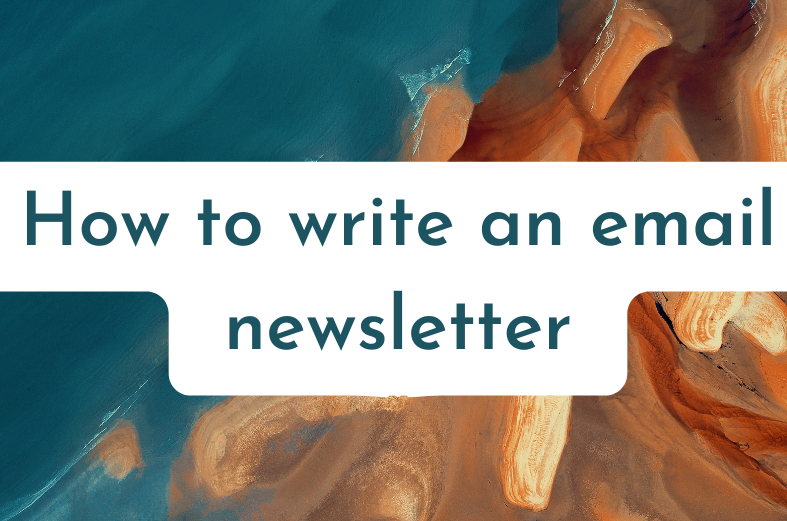
I will always encourage people to start to write an email newsletter. They have tons of advantages: you’re communicating with people who’ve actively opted in to hear from you; you can perfectly target your communications; you’re landing straight into their inboxes; and you own the list, so you’re not at the mercy of algorithms and social media companies’ whims.
One of the sticking points I hear a lot, though, is what the hell to put in it? It’s hard enough to come up with social media content and blog posts, and now you’re telling me I have to think of content for an email newsletter as well?
So you sit down to write an email newsletter. Now what?
The lovely thing about email newsletters is that there are no real rules to it, so you can do what you like. You don’t have to stick to whatever trends are boosting engagement on social platforms, or optimal posting schedules. When you write an email newsletter, you get to do what will engage YOUR email list, and remind them why they signed up to hear from you. The trick is to give them information they won’t get from you anywhere else.
This is what I like to do, anyway. I get a little bit more personal in my emails – because they’re not for everyone to see, like the blog. Emails are different; they’re something special, from me to you.
Obviously, if you’re doing a promotion, a launch, or you’re in a busy season (Christmas is coming, creative product-based business owners!), you’ll be wanting to write an email newsletter about those, at careful intervals. But if you don’t want to be one of those businesses that just sends out sales emails (though those can be valuable too), here are some ideas, either to get you started, or to get you unstuck. You can combine them, or if you’ve got enough to say, make them a whole newsletter of their own.
Ideas for what to write in an email newsletter
- Behind-the-scenes
Tales from behind the scenes are a great way to give your list a little peek behind the curtain, and learn more about what makes you tick. You can use it to tell them more about your story and how you work, or tease new things you’re working on (which you can use to build anticipation for when you launch). - Industry news
Share what’s going on in your industry – not only is it being helpful, it’s also showing that you keep yourself up-to-date. It might be design or fashion trends, or changes to social media platforms, or changes to best practice in your industry. Just make sure it’s also going to be interesting and relevant to your audience – if they’re following you for your jewellery designs, you probably don’t need to talk about the troy ounce price of silver. - Recommendations
Read a great book on a relevant topic lately? Discovered an amazing podcast? Review it! Be specific – tell them what you really liked about it, and what you’ve learned that you could use in the future. - Mistakes
It’s okay to make mistakes. Everyone likes to hear about another human being, well, human. Talk about a mistake you’ve made in your business – recently or a while ago – and what you’ve changed as a result. - Tips and tricks
Be generous – share some exclusive tips and tricks of your trade with your subscribers. It might be social media tips, or business tips, or styling tips, or care tips. - Tell a story
This could be a story of yours, or a story about someone else (an artist, maybe, or a historical figure who inspires you), that you can link into a lesson for yourself or your audience. - Package up and pass on wisdom from industry leaders
Stuck for something to say yourself? Look to what the experts are saying, and give your take on it. - Share what you’ve been publishing
Just because someone’s subscribed to your list, it doesn’t mean they’re necessarily up to date with all your other content. So if you’ve got some blog posts, or Medium articles, or podcast episodes (your own or someone else’s that you’ve guested on), share them with your list. - Lessons
We’re all learning, all the time. Have you learned something recently on a project? A hack to do something faster or better, or had a breakthrough with a technique you’ve been practicing, or a philosophical lightbulb moment? Or something you’ve noticed from following current trends, or something about yourself and how you work? - Free stuff
Creating exclusive content, like free downloadable resources, is a great way to show your subscribers how much you value them. This one’s a good one for service-based businesses – think things like worksheets, checklists, guides, photography…so many options! - Exclusive offers
There are all kinds of things you can offer your subscribers, and it doesn’t just have to be discount vouchers. It could be first pick of your new products, or a product that’s just for them, a competition, or a webinar. - Encourage questions
Get your readers to ask questions! This is a great way to generate new ideas for content and to get a handle on the things that they really want to know. You could use them to run an advice column, or package them up as an extra downloadable resource if you get enough. (But make sure you do reply personally, and check if they’re okay with you using their questions.)
And there you have it – 12 ideas to get you thinking about how you can start communicating with your people through email. Which will you use first?